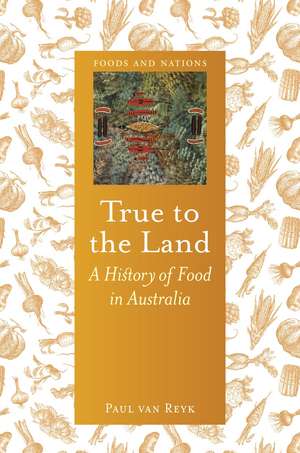True to the Land: A History of Food in Australia: Foods and Nations
Autor Paul van Reyken Limba Engleză Hardback – 11 oct 2021
Preț: 217.12 lei
Nou
Puncte Express: 326
Preț estimativ în valută:
41.55€ • 43.49$ • 34.58£
41.55€ • 43.49$ • 34.58£
Carte disponibilă
Livrare economică 10-24 martie
Livrare express 22-28 februarie pentru 45.81 lei
Preluare comenzi: 021 569.72.76
Specificații
ISBN-13: 9781789144062
ISBN-10: 178914406X
Pagini: 352
Ilustrații: 80 color plates, 30 halftones
Dimensiuni: 159 x 235 x 23 mm
Greutate: 0.82 kg
Editura: REAKTION BOOKS
Colecția Reaktion Books
Seria Foods and Nations
ISBN-10: 178914406X
Pagini: 352
Ilustrații: 80 color plates, 30 halftones
Dimensiuni: 159 x 235 x 23 mm
Greutate: 0.82 kg
Editura: REAKTION BOOKS
Colecția Reaktion Books
Seria Foods and Nations
Notă biografică
Paul van Reyk is a food writer living in Sydney, Australia. He is a regular presenter at the Symposium of Australian Gastronomy.
Recenzii
"It’s surprising, given how central food is to our lives, that serious studies of the food industry are only just hitting the mainstream. As van Reyk says in this comprehensive study, a history of food is not only about what we ate and eat. Central to his study is the concept of 'foodways'—how food is grown, produced, distributed, and consumed. He takes us back to Indigenous land-management and food practices, through the colonial period and the introduction of European farming to the present day and the new breed of farmers engaging with regenerative practices and looking to native crops."
"Van Reyk begins his story of Australian foodways some 50,000 years ago, and leaves us in 2020 amid serious concerns about climate change, drought, and the threat of bushfires (to all of which he pays full attention). Land, climate, and distance have profound impacts on what we eat and how much it costs. . . . There often seems to be something small and petty about food interests . . . unless we examine the bigger picture, and include agriculture and supply. Van Reyk is very good at correcting this as well as including the currency of food shifts and crazes; the follies of aspirations."
"Ambitiously evaluates the foodways of this land over 65,000 years. . . . I highly recommend True to the Land to the general public, university students of food history, school teachers and academics. This food history is also relevant to researchers on Australian history, colonial history and cultural and social histories."
"A thorough examination of Australia’s culinary history. . . . Divided into ten chapters and organized historically, the book describes the foodways of the first peoples, the colonization of Australia, during wartime and between wars, Federation, post-colonialism and modernity; it ends with the themes of Australia as a foodie nation and millennial reckonings. . . . A skillfully written overview of Australian food history, detailing the evolution of Australian foodways and agriculture while acknowledging the contributions of the many cultures that make up contemporary Australia."
"Aimed at a broad readership, this book is no romp through the tantalizing delights and clichéd curiosities of 'slippery bob, ' 'kangaroo steamer,' and the like, and it contains only a few recipes. Van Reyk’s voice is direct but relatively informal, his pacing lively but unrushed, but True to the land is a serious and well researched study. . . . True to the land is well worth the attention of those interested in Australian gastronomic history in its many guises—political, economic, cultural, and environmental—and how these entities now shape our food future."
"In Australia, more than anywhere else, we are what we eat. From everyday acts of multiculturalism handed over the fence to locking up the families of Tamil meatworks employees: food here is so much more than sustenance. Paul van Reyk’s book is a rich introduction into that conundrum. The only thing is the title. True to the Land? I wish we could be."
"A comprehensive history of the food of Australia, from its beginning with the First Nations people 60,000 years ago to 2020."
"A masterful overview of Australian food history and foodways, including their social and political implications and the influences of scientific and technological advances. From millennia-old fish traps to television’s MasterChef Australia, by way of damper and mutton, lamingtons and Anzacs, it charts the evolution of Australian food and agriculture, acknowledging the contributions of the many cultures that make up contemporary Australia."








